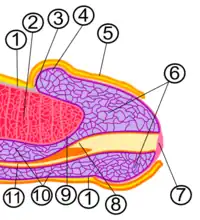| Corona of glans penis | |
|---|---|
 Corona of glans overhanging the neck of the erect and aroused penis. | |
| Details | |
| Artery | Dorsal artery of the penis |
| Vein | Dorsal veins of the penis |
| Nerve | Dorsal nerve of the penis |
| Identifiers | |
| Latin | corona glandis penis |
| TA98 | A09.4.01.008 |
| TA2 | 3669 |
| FMA | 19627 |
| Anatomical terminology | |
The corona of glans penis (or, directly from the Latin, the corona glandis penis[1]) or penis crown refers to the rounded projecting border or flare that forms at the base of the glans in human males. The corona overhangs a mucosal surface, known as the neck of the penis, which separates the shaft and the glans.[2] The deep retro-glandular coronal sulcus forms between the corona and the neck of the penis. The two sides of the corona merge on the ventral midline forming the septum glandis.[3] The circumference of the corona is richly innervated and is described as a highly erogenous area of the glans.[4]
Anatomy
Development
During the embryonic development of the male fetus, a thickening on the epidermis appears around the base of the developing glans.[5] The thickening separates from the glans creating the preputial fold and the preputial lamina on its ventral surface.[6] The lamina expands outwards over the epithelium of the glans and also backwards forming an ingrowing fold at the base of the glans that will become the coronal sulcus.[7]
Vascularization
The corona and the neck are highly vascularized areas of the penis. The axial and dorsal penile arteries merge together at the neck before entering the glans.[8] Branches of the dorsal artery of the penis curve around the distal shaft to enter the frenulum and the glans from its ventral surface.[9] Small venous tributaries deriving from the corona drain the glans forming a venous retro-coronal plexus before merging with the dorsal veins.[8]
Innervation
The circumference and the underside of the corona are densely innervated by several types of nerve terminals, including genital corpuscles and free nerve endings, and are considered by males a highly erogenous zone of their penis.[4][10] The area is reported to be particularly responsive to stimulation and a source of distinct sexual pleasure.[11][12]
Penile papules
In some males, small skin-colored bumps, known as pearly penile papules, may appear at the circumference of the corona. Their appearance may vary from being hardly noticeable in some men to more prominent and well-defined in others. The papules are painless, harmless and non sexually transmitted. They usually appear in late puberty and are thought to disappear with age.[13] Even though they do not require treatment, they can easily be removed, especially for aesthetic purposes.[14]
Gallery
 3. Coronal sulcus
3. Coronal sulcus
4. Corona of the glans The glans penis of an uncircumcised and a circumcised male
The glans penis of an uncircumcised and a circumcised male Corona of glans penis
Corona of glans penis
References
- ↑ The American Journal of the Medical Sciences. Vol. 75. 1878. p. 52.
- ↑ Sam, Peter; LaGrange, Chad A. (2022), "Anatomy, Abdomen and Pelvis, Penis", StatPearls, Treasure Island (FL): StatPearls Publishing, PMID 29489230, retrieved 2022-12-19
- ↑ Özbey, Hüseyin; Kumbasar, Ali (2017). "Glans wings are separated ventrally by the septum glandis and frenulum penis: MRI documentation and surgical implications". Turkish Journal of Urology. 43 (4): 525–529. doi:10.5152/tud.2017.00334. ISSN 2149-3235. PMC 5687219. PMID 29201519.
- 1 2 Halata, Z.; Munger, B. L. (1986-04-23). "The neuroanatomical basis for the protopathic sensibility of the human glans penis". Brain Research. 371 (2): 205–230. doi:10.1016/0006-8993(86)90357-4. ISSN 0006-8993. PMID 3697758. S2CID 23781274.
- ↑ Liu, Xin; Liu, Ge; Shen, Joel; Yue, Aaron; Isaacson, Dylan; Sinclair, Adriane; Cao, Mei; Liaw, Aron; Cunha, Gerald R.; Baskin, Laurence (2018). "Human glans and preputial development". Differentiation; Research in Biological Diversity. 103: 86–99. doi:10.1016/j.diff.2018.08.002. ISSN 1432-0436. PMC 6234068. PMID 30245194.
- ↑ Fahmy, Mohamed A. Baky (2020), Fahmy, Mohamed A. Baky (ed.), "Embryology of Prepuce", Normal and Abnormal Prepuce, Cham: Springer International Publishing, pp. 29–33, doi:10.1007/978-3-030-37621-5_4, ISBN 978-3-030-37621-5, S2CID 216479793, retrieved 2023-01-07
- ↑ Cunha, Gerald R.; Sinclair, Adriane; Cao, Mei; Baskin, Laurence S. (2020). "Development of the human prepuce and its innervation". Differentiation; Research in Biological Diversity. 111: 22–40. doi:10.1016/j.diff.2019.10.002. ISSN 1432-0436. PMC 6936222. PMID 31654825.
- 1 2 Quartey, J. K.M. (2006), Schreiter, F.; Jordan, G.H. (eds.), "Anatomy and Blood Supply of the Urethra and Penis", Urethral Reconstructive Surgery, Berlin, Heidelberg: Springer, pp. 11–17, doi:10.1007/3-540-29385-x_3, ISBN 978-3-540-29385-9, retrieved 2022-12-19
- ↑ Hinman, F. (1991). "The blood supply to preputial island flaps". The Journal of Urology. 145 (6): 1232–1235. doi:10.1016/s0022-5347(17)38584-1. ISSN 0022-5347. PMID 2033699.
- ↑ Schober, Justine M.; Meyer-Bahlburg, Heino F. L.; Dolezal, Curtis (2009). "Self-ratings of genital anatomy, sexual sensitivity and function in men using the 'Self-Assessment of Genital Anatomy and Sexual Function, Male' questionnaire". BJU International. 103 (8): 1096–1103. doi:10.1111/j.1464-410X.2008.08166.x. ISSN 1464-410X. PMID 19245445. S2CID 38304794.
- ↑ Yang, Claire C.; Bradley, William E. (1999-01-01). "Innervation of the human glans penis". Journal of Urology. 161 (1): 97–102. doi:10.1016/S0022-5347(01)62075-5. PMID 10037378.
- ↑ Haas, Kurt; Haas, Adelaide (1993). Understanding Sexuality. Mosby. ISBN 978-0-8016-6748-0.
- ↑ "Pearly Penile Papules: Causes, Symptoms & Treatment". Cleveland Clinic. Retrieved 2022-12-19.
- ↑ Aldahan, Adam S.; Brah, Tara K.; Nouri, Keyvan (2018). "Diagnosis and Management of Pearly Penile Papules". American Journal of Men's Health. 12 (3): 624–627. doi:10.1177/1557988316654138. ISSN 1557-9891. PMC 5987947. PMID 27316776.
 This article incorporates text in the public domain from page 1249 of the 20th edition of Gray's Anatomy (1918)
This article incorporates text in the public domain from page 1249 of the 20th edition of Gray's Anatomy (1918)
External links